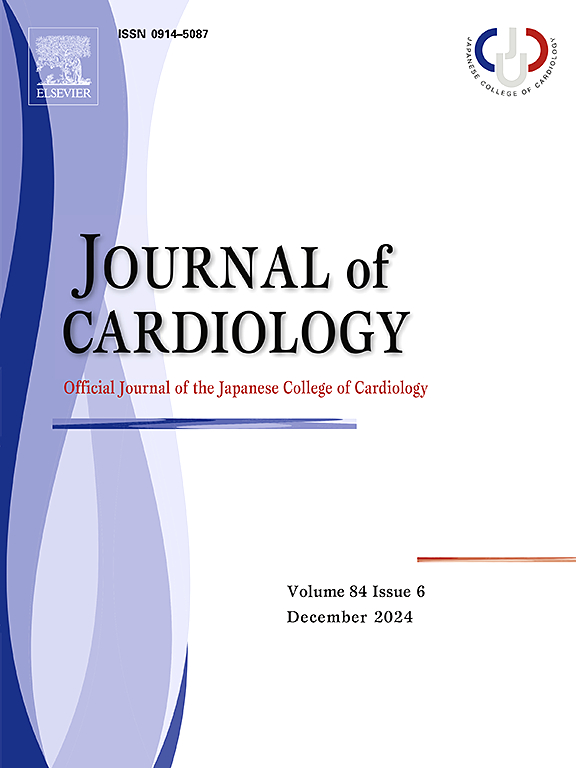Goreisan(一种日本草本锦囊药)的辅助使用与心衰再入院之间的关系:一项全国范围的倾向得分匹配研究。
IF 2.5
3区 医学
Q2 CARDIAC & CARDIOVASCULAR SYSTEMS
引用次数: 0
摘要
背景:五味子是一种日本草药,具有调节体液平衡的作用,因此可作为标准疗法的补充,有效改善心力衰竭(HF)患者的预后:我们利用日本诊断程序组合数据库,回顾性地识别了 431,393 名患者(平均年龄为 79.2 ± 12.6 岁;男性占 52.3%),这些患者在 2016 年 4 月至 2021 年 3 月期间首次因心力衰竭入院,并在接受标准心力衰竭药物治疗后存活出院。我们根据患者出院时的高乐散处方将其分为两组:接受标准心房颤动药物加高乐散治疗的患者和仅接受标准药物治疗的患者。我们使用倾向得分匹配法比较了两组患者出院后 1 年内高血压再入院的发生率:总体而言,1957 例(0.45%)患者在出院时使用了歌礼生。与未接受戈瑞散治疗的患者相比,接受戈瑞散治疗的患者年龄更大,接受利尿剂治疗的频率更高。通过一对四的倾向评分匹配,分别产生了1957名和7828名使用和未使用戈瑞散的患者。两组患者的 1 年高血压再入院发生率无明显差异[22.1% vs. 21.7%;危险比 (HR) = 1.02,95% 置信区间 (CI) = 0.92-1.13]。这一结果与竞争风险分析(子分布 HR = 1.02,95 % CI = 0.92-1.13)和临床相关亚组(肾病除外)的结果一致。在肾病患者中,使用戈瑞散与较低的高血压再入院发生率相关(HR = 0.77,95 % CI = 0.60-0.97),但在非肾病患者中则不相关(HR = 1.09,95 % CI = 0.97-1.23;交互作用 p = 0.009):这项全国范围内的倾向得分匹配分析并未证明,在接受标准药物治疗的心房颤动患者中,出院时使用戈瑞散辅助治疗与较低的心房颤动一年再入院率有关。目前正在进行一项随机试验,以确定戈瑞散对心房颤动患者的疗效。本文章由计算机程序翻译,如有差异,请以英文原文为准。

Association between complementary use of Goreisan (a Japanese herbal Kampo medicine) and heart failure readmission: A nationwide propensity score-matched study
Background
Goreisan, a Japanese herbal medicine, possesses aquaretic properties to regulate body fluid homeostasis and may therefore be effective as a complement to standard therapy in improving outcomes in patients with heart failure (HF).
Methods
We retrospectively identified 431,393 patients (mean age 79.2 ± 12.6 years; male 52.3 %) who were admitted for HF for the first time and were discharged alive with standard HF medications between April 2016 and March 2022, using the Japanese Diagnosis Procedure Combination database. We divided patients into two groups according to the prescription of Goreisan at discharge: patients who received standard HF medications plus Goreisan and those who received standard medications alone. We compared the incidence of HF readmission within 1 year after discharge between the groups using propensity score matching.
Results
Overall, Goreisan was prescribed in 1957 (0.45 %) patients at discharge. Patients who received Goreisan were older and received diuretics more frequently than those who did not. One-to-four propensity score matching created a cohort of 1957 and 7828 patients treated with and without Goreisan, respectively. No significant difference was found in the incidence of 1-year HF readmission between the groups [22.1 % vs. 21.7 %; hazard ratio (HR) = 1.02, 95 % confidence interval (CI) = 0.92–1.13]. This result was consistent with that from competing risk analysis (subdistribution HR = 1.02, 95 % CI = 0.92–1.13) and across clinically relevant subgroups except for renal disease. Goreisan use was associated with a lower incidence of HF readmission among patients with renal disease (HR = 0.77, 95 % CI = 0.60–0.97), but not among those without (HR = 1.09, 95 % CI = 0.97–1.23; p for interaction = 0.009).
Conclusions
This nationwide propensity score-matched analysis did not demonstrate that complementary Goreisan use at discharge was associated with a lower incidence of 1-year HF readmission in patients with HF receiving standard medications. An ongoing randomized trial is awaited to establish the effectiveness of Goreisan use in patients with HF.
求助全文
通过发布文献求助,成功后即可免费获取论文全文。
去求助
来源期刊

Journal of cardiology
CARDIAC & CARDIOVASCULAR SYSTEMS-
CiteScore
4.90
自引率
8.00%
发文量
202
审稿时长
29 days
期刊介绍:
The official journal of the Japanese College of Cardiology is an international, English language, peer-reviewed journal publishing the latest findings in cardiovascular medicine. Journal of Cardiology (JC) aims to publish the highest-quality material covering original basic and clinical research on all aspects of cardiovascular disease. Topics covered include ischemic heart disease, cardiomyopathy, valvular heart disease, vascular disease, hypertension, arrhythmia, congenital heart disease, pharmacological and non-pharmacological treatment, new diagnostic techniques, and cardiovascular imaging. JC also publishes a selection of review articles, clinical trials, short communications, and important messages and letters to the editor.
 求助内容:
求助内容: 应助结果提醒方式:
应助结果提醒方式:


